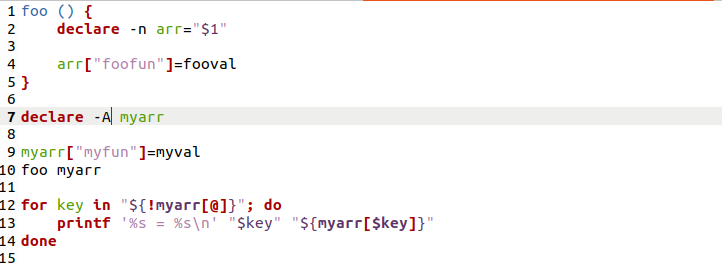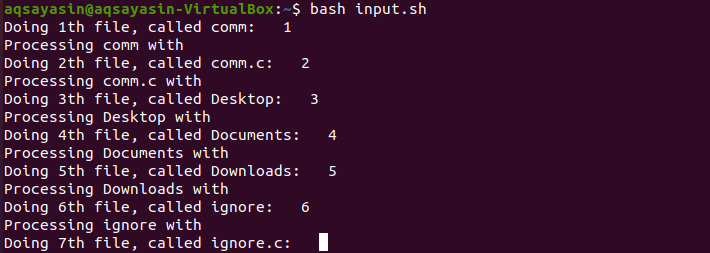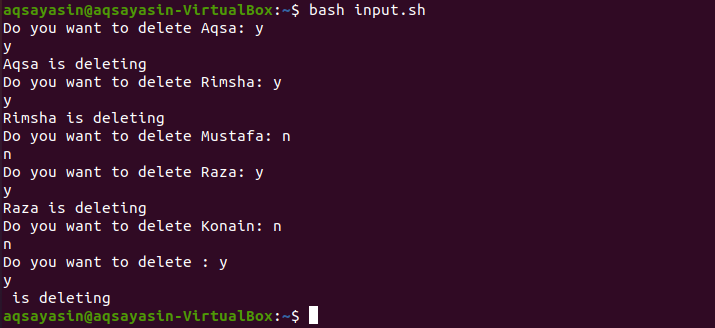Stdin: 1
Let’s begin by understanding through practice about Stdin Stream using while loops. At very first, we will be having a basic example of the stdin as read. Execute the instruction below. The instruction would demand keyboard input. In this, through stdin, the reading tool gets the text.
Example 01:
Create a new file, “input.sh” and add the appended script to it. We have been using the while loop to read the text by a user from the terminal and print it. The script is named with a “/dev/stdin” as the very first $1 parameter, in which the corresponding approach reads the regular input from the console. Save this file and close it.
Open the terminal, and run the newly updated file “input.sh” as:
When you execute the file using the bash command, you will be jumped to the next line to write something. As you can see below, the user has written a one-line text and press Enter.
The text written by a user will be read out first and printed out on the next line as below.
You can even provide one space between your text input as below.
Example 02:
Now we will read the text from the file. Update the same file “input.sh” by providing the filename “script.sh” as the very first $1 parameter. The corresponding approach reads from this document.
We have the following text information in the file “script.sh” as below. Let’s check how it works.
Execute the file “input.sh” using the bash command. You will see that the read stream reads out from the provided file “script.sh” and print it out in the terminal as below.
Example 03:
Let’s have an example to read each directory one by one using stdin. You have to consider the parameter -u with the read. In this, “-u 1” implies “read from stdin.” In this code, “line” represents the filename, and the increment “i++” is used to jump over to the next directory or file. It will also count the file number that has been read as well. Let’s run this code to check what happens next.
Execute the bash file “input.sh”. It will prompt you to enter some text to jump over to the next file. Here “comm” represents the name of the first file.
While continuing this, you can see we have a list of files that we have gone through.
Example 04:
In this example, we have two related files to read from. Assign the required privileges to both files using the “Chmod” command as below.
Write the below code in the file “input.sh”. Until the “while” loop is getting lines, it will print those lines. While the “line” refers to another file “script.sh”.
We have the below code in the file “script.sh”. While the loop is running, it is printing the line number.
Execute both files using “”./” at the start of the filename and separating using “”|” in the shell. You will see that it is printing the line numbers while printing the text from the files as well. It’s a very simple method to correlate two files or their contents.
Example 05:
Let’s end this topic by having this simple and efficient example. We have a file “script.sh” with the below contents or names of persons. We will be reading these names one by one from another file.
Update the file “input.sh: with the below script. In this script, we have a while loop to elaborate “stdin” working. We have been using read “read –r” while reading from another file as other than standard input. On the other hand, using “-u” as bash-specific, the standard output from the user in the terminal. Here, the “name” is the text or content of the file “script.sh”. The option “-p” is used to “read”. The read statement will read the “name” from another file and ask if you want to delete it or not. The keyword “ip” is used for user response to affirm the action of deletion. Whatever the user response is, it will print it out. In the “if” statement, it will check if the standard input from the user is same as “y”, then it will print out some message as mentioning that it has been deleting the “name”. This process will be reiterated until the last content of the file “script.sh”.
Let’s have a look at the output of the above code. Execute the file using the bash command. The system will ask you if you want to delete this “name” or not. Enter “y” and tap “Enter”.
Here on pressing “y”, it will print “y” and show a message that it has been deleting the particular “name”. After that, it will switch to another “name”.
It will ask you to delete the names until all the names or contents of file “script.sh” have been lopped over as below.
Conclusion:
We have magnificently gone through all the simple examples of standard input while using the “while” loop in the bash script.















